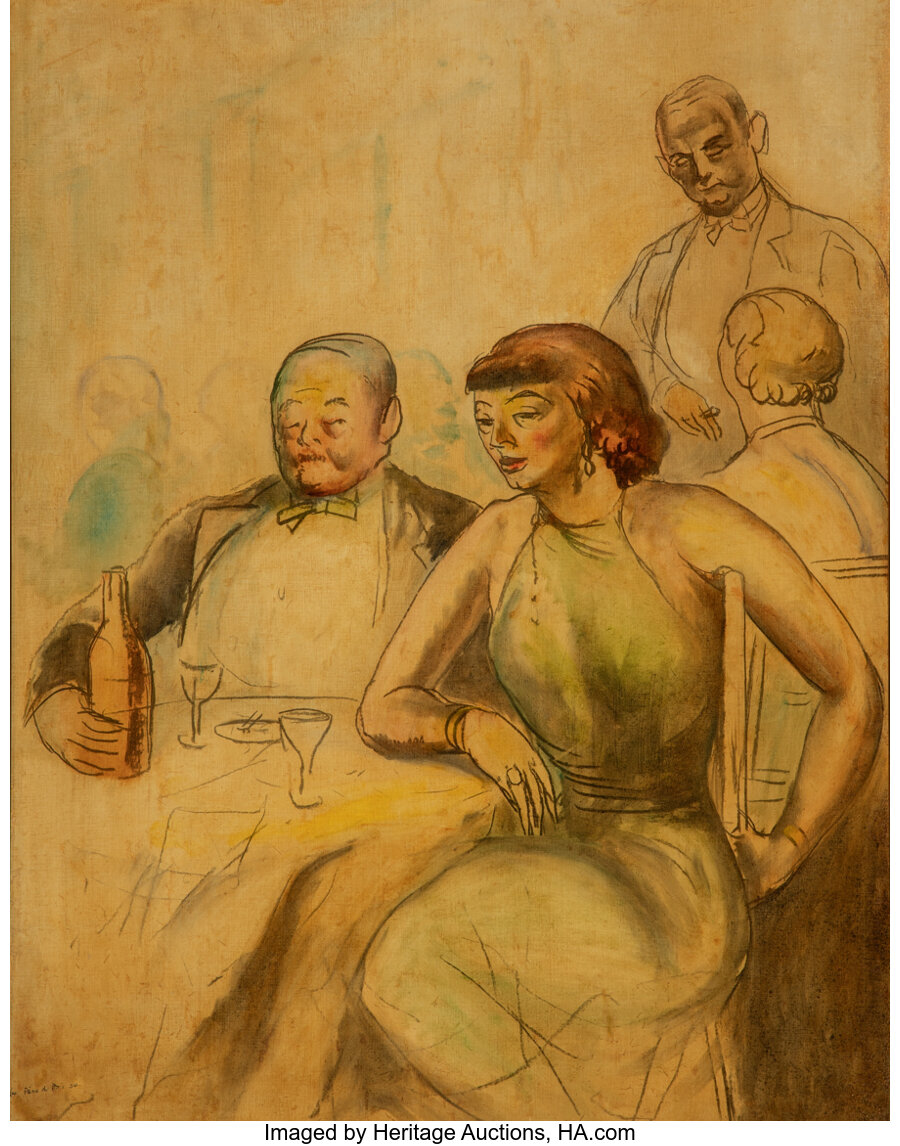Signed and dated lower left: Guy Pene du Bois 34
Polk Museum of Art, Lakeland, Florida, "Edward Hopper and Guy Pène du Bois: Painting the Real," December 17, 2022-March 26, 2023.
The artist; Estate of the above; James Graham & Sons, New York, acquired from the above; Private collection, Arizona.
Guy Pène du Bois (American, 1884-1958) Enjoying the Show, The Jumble Shop Tea and Tap Room, The Bal Masque, 1934 Oil and charcoal on canvas 51 x 40 inches (129.5 x 101.6 cm) Signed and dated lower left: Guy Pene du Bois 34 PROVENANCE: The artist; Estate of the above; James Graham & Sons, New York, acquired from the above; Private collection, Arizona. EXHIBITED: Polk Museum of Art, Lakeland, Florida, "Edward Hopper and Guy Pène du Bois: Painting the Real," December 17, 2022-March 26, 2023. In the wake of the repeal of Prohibition, the Bal Masque Jumble Shop on 8th Street, a renowned New York artists' bar and club, sought the artistic talents of Guy Pène du Bois in 1934. The fruits of this collaboration were a series of murals, of which only two of the original ten have survived. While Pène du Bois' earlier works from the 1910s and 1920s are characterized by social commentary and a certain degree of "type-casting," these murals distinguish themselves as an exploration of relationships, differing markedly from stereotypical illustrations of human connections. Enjoying the Show is of a scene only months after Prohibition has been repealed, in a stylish New York venue in Greenwich Village that was frequented by artists and connoisseurs, from 1927 (when it was no doubt a speakeasy) to 1967. The painting was one of ten murals that Pène du Bois was commissioned to make for the establishment – a restaurant and nightclub that was modeled on the cafes of Paris and was a convening site for painters and literary artists, American and from abroad. Reginald Marsh, Stuart Davis, Arshile Gorky, John Graham and others enlivened the walls with caricatures and contributed to the atmosphere with conversations about art. Later regulars included Williem de Kooning, Jackson Pollock, Lee Krasner and Martha Graham, and like-minded French visual and literary artists such as the painter, Jean Helion, film star, Jean Gabin, and philosopher, Simone de Beauvoir. Pène du Bois's Jumble Shop murals presented the sort of scenes the artist would have witnessed when in Paris, attending the Bal des Quat'z'Arts, when in New Orleans at Mardi Gras celebrations and when in New York at the Penguin Club annual ball on East 15th Street. One reviewer described the murals as "a series of ten episodes telling the story of a typical evening at bal masque, from the entrance of the party to its final, struggling departure." Enjoying the Show captures perhaps the midpoint of such an evening. Knowing that the murals were to be installed in a below-ground club where smoking, drinking, and dining were predominant, the artist explored a new method of painting. First, he drew in charcoal the lines that would become the figures and objects; then over the drawings, he applied a layer of varnish. When that had dried, he painted in all the colors and shades that were to be the core setting and elements of the scene; and after that paint had dried, a final layer of varnish was applied, "locking-in" all lines and colors. Pène du Bois's skill as a colorist can be seen in all parts of the painting. He uses colors in unexpected places: the blue in the man's balding head; the orangey red in the liquor bottle; the faint skin tones of the figures; and the golden undertone that runs throughout the painting all blend effortlessly with the drawn lines. Pène du Bois thought he had hit upon a new process of painting, that by using repeated layers of varnish over graphite and then again over color pigment, he could achieve a golden tone that would fit both the subject of a bal masque and the interior setting, while also protecting the painting from the pollutants apt to permeate a New York City underground nightclub. What he possibly did not know was that it was exactly the process used by the British artist, Joseph Mallord William Turner, also to achieve the golden cast for which many of his best paintings were known, but more particularly to be used on Varnishing Days of Royal Academy Exhibitions so as to better his adversary, John Constable, in reviews and sales. The final straw for Turner at the 1831 R.A. Hanging Day was when he saw that Constable had removed his painting, which had been hung by the Committee in the most prominent placement, and placed it below eye level and alongside another artist's work. The following year, at the 1832 Exhibition, Constable's painting, and Turner's much smaller seascape were hung alongside each other in the Academy's Inner Room. Seeing a profusion of red flags on the ships in Constable's painting, The Opening of Waterloo Bridge, Turner, on Varnishing Day, added a small shape of bright red to his own painting of ships at sail, Helvoetsluys, which he then turned into a buoy in the foreground, a splash of vibrant color that all viewers agree transformed the seascape into a suspenseful and powerful work. Pène du Bois' adaptation of just such a varnishing was to make sure the paintings would last but that they would also, with their golden tone, shine and give life to the underground setting that was the Jumble Shop club. HID12401132022 © 2024 Heritage Auctions | All Rights Reserved
Lined canvas. Condition report available upon request.
Framed Dimensions 60 X 48.5 Inches

